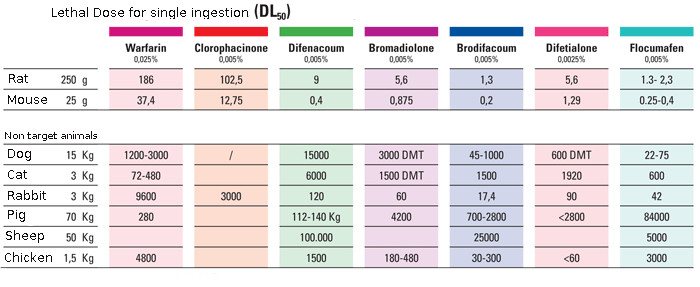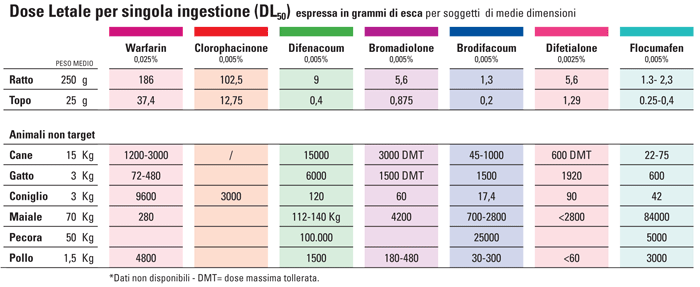Le restrizioni cui stanno andando incontro le esche rodenticide impongono una conoscenza minuziosa della tossicità per gli animali target e per quegli non target.
I prodotti devono quindi combinare la massima efficacia con la minor pericolosità possibile.
Partiamo dal presupposto che i veleni anticoagulanti appartengono tutti ad una medesima famiglia,quella delle idrossicumarine ed il cui meccanismo d’azione si basa sul blocco della sintesi epatica della Vitamina K che è un fattore fondamentale della coagulazione del sangue. Poiché nel fegato sono presenti scorte di questa Vitamina K ed alcuni alimenti,cosiddetti epatoprotettori, ne prolungano la disponibilità,possono esseri necessari alcuni giorni prima che il roditore che ha ingerito l’esca cominci a manifestare i primi sintomi di avvelenamento.Questo si conclama con emorragie che a partire dal sistema vascolare periferico andranno poi a colpire gli organi vitali provocando la morte.L’agonia non dura giorni ma un limitato periodo successivo all’ingestione dell’esca.Il successo delle esche anticoagulanti che da oltre 60 anni non hanno conosciuto rivali, stà proprio nel fatto che il decesso avviene dopo diversi giorni dall’ingestione, per cui non vi è una correlazione diretta per i roditori tra l’ultimo cibo ingerito ed il loro malessere.
Invece per quanto riguarda la nota “mummificazione”, fenomeno sicuramente agevolato dalle emorragie, questa avviene pero’ solo se vi è concomitanza di altre condizioni tra cui le più importanti sono la temperatura e l’umidità ambientale.
La tabella sopra esposta ci supporta nella scelta del principio attivo perché si vede con chiarezza come vi siano differenze sostanziali tra un principio attivo e l’altro a livello di DL50 ossia la Dose Letale oltre la quale si registra la morte del 50%+1 dei soggetti trattati a dosi crescenti della sostanza attiva.
A partire dal Warfarin e dal Clorophacinone che sono principi attivi anticoagulanti della I generazione andando verso destra nella tabella aumenta la “potenza” del principio attivo,che sarà tanto più letale quanto meno ne occorre per provocare la morte del roditore trattato.
Gli anticoagulanti della I generazione non vengono praticamente più usati perché i roditori hanno sviluppato una resistenza verso questi principi attivi,forse a causa delle massicce dosi di prodotto a cui sono state esposte negli anni passati.Potendone avere comunque a disposizione non sarebbe una cattiva idea effettuare derattizzazioni spot con questa classe di prodotti che hanno una bassa tossicità,anche se necessitano di essere mangiati in maggiore quantità per espletare il loro meccanismo d’azione.
Andando invece nella parte destra della tabella si vede come prodotti come il Floucomafen,il Difethialone e il Brodifacoum necessitano di dosi minori per essere letali, sia per i roditori che per gli animali non bersaglio.
Sono quindi molto potenti e di questo bisogna tenere conto qualora si effettuino derattizzazioni nelle aree esterne dove i roditori avvelenati possono potenzialmente essere predati, e quindi provocare una intossicazione secondaria sulla fauna selvatica intesa come volpi,donnole,rapaci notturni e diurni ecc. o da predatori occasionali come animali di allevamento,cani, gatti ecc.
L’ appetibilità che i principi attivi conferiscono all’esca è diversa da principio attivo a principio attivo e quindi va testata sul campo,sopratutto per i prodotti più recenti (invece per prodotti a base per esempio di Bromadiolone esiste un’ampia esperienza operativa e sperimentale)
Romani Disinfestazioni non effettua derattizzazioni sistematiche su larga scala con Difethialone,Floucomafen e Brodifacoum ossia il loro utilizzo non viene da noi adottato per derattizzazioni nelle aree esterne ove vi sia anche un rischio remoto di intossicazione secondaria su altre specie animali ma solo per interventi veramente mirati e specifici.
Questo scenario di potenziale rischio è più frequente di quanto si pensi e lo riscontriamo nei seguenti ambiti operativi:
- Giardini privati dove sono presenti cani,gatti ed altri animali da compagnia
- Piccoli e grandi allevamenti avicoli,suini,elicicoltura ecc
- Zoo e canili
- Derattizzazioni di aree esterne di aziende alimentari in contesti semi-urbani o di campagna (tipologia molto frequente perchè le Aziende difficilmente insistono in un contesto urbano)
- Parchi pubblici,privati e parchi naturali
- Aree pubbliche per campagne di derattizzazione urbana
Ad oggi non vi sono alternative chimiche applicabili all’uso degli anticoagulanti per cui occorre comunque fare ricorso a questi principi attivi per effettuare campagne di derattizzazione nelle aree esterne.
Utilizzando prodotti a base di Difenacoum e Bromadiolone si riesce efficacemente a sfruttare i notevoli pregi di questi principi attivi, tra cui la buona appetibilità (il Bromadiolone addirittura sembra un principio attivo migliorativo del gusto) , l’assenza di fenomeni di resistenza almeno in Italia, l’elevata efficacia contro i roditori,la disponibilità dell’esca in blocchetti paraffinati che sono enormenente piu’ sicuri di altre formulazioni, la minore pericolosità per animali non bersaglio.
Nel nostro Calendario dei Veleni effettuiamo una rotazione di questi due principi attivi, il Difenacoum e il Bromadiolone,non tanto per aggirare eventuali fenomeni di resistenza,(remoti comunque in quanto i prodotti appartengono alla stessa famiglia di prodotti), quanto per una ottimizzazione operativa ed una turnazione efficiente che garantisca freschezza dei prodotti ed anche rintracciabilità immediata dei lotti.
A volte ci siamo confrontati con altri colleghi in merito al contemporaneo utilizzo di più tipi di principio attivo nel medesimo erogatore, pratica che non ci trova concordi proprio per i motivi del diverso impatto di ciascun principio attivo.Qualora si intenda più facilmente intercettare l’andamento dei consumi di esca occorrerà effettuare passaggi più frequenti e in quella sede effettuare le sostituzioni del caso qualora un prodotto sia più gradito dell’altro.
Rosi Norman
RQ Romani Disinfestazioni Srl Lucca
How to choose the active ingredient in the rodent control

The restrictions which are going to meet with rodenticide baits require a detailed knowledge of the toxicity to target animals and for those not targeted.
The products must therefore combine maximum efficiency with the least possible hazard.
We assume that the anticoagulant poisons all belong to the same family, of idrossicumarine and whose mechanism of action is based on the block of hepatic synthesis of K Vitamin which is a fundamental factor of the blood clotting . As stocks of K vitamin are already present in the liver and some foods, so-called hepatic protectors, offer extended availability, it may need a few days before the rodents who ingested the bait begins to show the first symptoms of poisoning. This bring to overt bleeding from the peripheral vascular system and then will hit the vital organs causing death. The agony does not last very long but only for a limited period following the ingestion of the bait. The success of anticoagulant baits has for over 60 years have no rivals, is in the fact that the death occurs several days after the ingestion, so there is not a direct correlation for the rodents between the last food ingested and the own illness or of their similar.
Instead, in regards of the “mummification”, a phenomenon certainly facilitated by bleeding, this happens, however, only if there is concurrence of conditions including the most important are the temperature and the ambient humidity.
The table above supports us in the choice of the active ingredient because it can clearly be seen that there are substantial differences between an active ingredient and the other at the LD50 level namely the lethal dose beyond which records the death of 50% + 1 of subjects treated with increasing doses of the active substance.
Starting from Warfarin and Clorophacinone which are the first generation anticoagulant active ingredients going toward the right in the table the “power” of the active ingredient rise, which will be much more less lethal as it is necessary to cause the death of the treated rodent.
The first generation of anticoagulants are not practically used anymore because the rodents have developed resistance to these agents, perhaps because of the massive amounts of product that have been exposed over the past years. If there was still availability it would not be a bad idea to perform rodent control with this class of products that have a low toxicity, even if they need to be eaten in greater quantities to perform their action.
Going instead in the right part of the table you can be seen as products such as Floucomafen, Difethialone and Brodifacoum require smaller doses to be lethal even for non-target animals.
They are therefore very powerful and this must be taken into account if it is to conduct rodent control in the outer areas where the poisoned rodents can potentially be preyed upon, and therefore cause a avifauna secondary poisoning such as foxes, weasels, nocturnal and diurnal birds of prey or occasional predators such as farm animals, dogs, cats etc.
The palatability which give the bait goes tested in the field as much as the recent products compared to other for example the Bromadiolone of which there is a wide operational experience.
Romani Pest Control doesn’t do systematic deratization with the latter three active ingredients, they aren’t used by us for rodent control in outdoor areas where there is even a remote risk of secondary poisoning on other animals.
This scenario is more common than you think and we find it in the following areas:
- Gardens where there are dogs and cats
- Small rabbit farms and domestic coops
- Herds of pigs, animal shelters, Zoo
- Deratization of outdoor areas of food companies in semi-urban contexts or country (very common type because the companies hardly insist in an urban context)
- Parks with the presence of small lakes and birds of different species
To date there are no applicable chemical alternatives to the use of anticoagulants, that must still resort to these active ingredients, to make rodent control campaigns for the prevention against intrusion in the indoor areas.
Using products based on Difenacoum and Bromadiolone is able to exploit the considerable advantages of these active ingredients, including the good palatability (the Bromadiolone even seems an active ingredient for taste improvement), the absence of phenomena of resistance at least in Italy, the high efficacy against rodents, the availability of the bait in paraffin blocks which are hugely safer than other formulations and the less hazardous to non-target animals.
In our calendar of poisons we carry out a rotation of these active ingredients, not to circumvent any resistance phenomena (remote in any case because the products belong to the same family) and for operational optimization and efficient shift system that ensures the product freshness and also immediate traceability of lots.
Sometimes we are confronted with other colleagues on the simultaneous use of multiple types of active ingredient in the same dispenser, a practice that we disagree on for the reasons of the different impact of each ingredient . In case there’s a wish to more easily intercept the trend of a bait consumption is necessary to have more frequent visits and on that occasion make substitutions in case a product is more acceptable than the other.
Rosi Norman
Romani Disinfestazioni Srl LUCCA Tel 0583-955344 Cell 337-1238029
Controllo Qualità


